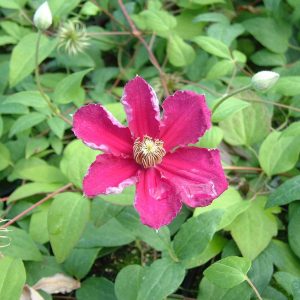Description
Thymus ‘Fragrantissimus’ is a cultivar of Orange thyme, a hybrid mint plant in the Lamiaceae family. The plant is a perennial herb that is known for its strong citrus aroma and flavor, with a hint of thyme. The leaves are green and have a slightly serrated edge. It produces small, white or pink flowers during the summer. The leaves can be used fresh or dried to flavor a variety of dishes, particularly in Mediterranean and French cuisine, and also to make teas. This cultivar is particularly well-known for its strong aroma and flavor, and it’s often used in perfumery and aromatherapy. It is a low-maintenance and hardy plant that can be grown in a variety of soils and prefers partial to full sun.
Key Facts
- Common Name(s):Orange Thyme
- Hardiness:Fully hardy through most of the UK
- How big will I get? Thymus ‘Fragrantissimus’ can grow to a height of 0.1m and a spread of 0.5m.
- Did You Know That:The leaves of T. ‘Fragrantissimus’ can be harvested throughout the growing season, but it is best to harvest them just before the plant flowers for the best flavor and aroma.
Plant Calendar
A rough guide to how this plant will change through the year.
| Jan | Feb | Mar | Apr | May | June | July | Aug | Sept | Oct | Nov | Dec | |
| Flowering Time |  |
 |
 |
|||||||||
| Foliage Colour |  |
 |
 |
 |
 |
 |
 |
 |
 |
 |
 |
 |
| J | F | M | A | M | J | J | A | S | O | N | D |
 |
 |
 |
|||||||||
 |
 |
 |
 |
 |
 |
 |
 |
 |
 |
 |
 |
Care Guide

Soil Requirements
Thymus ‘Fragrantissimus’ is a versatile plant and can cope with wet or drier soils, but prefers there to be decent drainage. This plant can grow in soil with a wide range of pH levels, it is not picky about the pH level of the soil.

Best Position
Thymus ‘Fragrantissimus’ prefers a sheltered position and requires full sun to thrive, this consists of more than six hours of direct sunshine per day.

Maintenance
Thymus ‘Fragrantissimus’ should be cut back after it finishes flowering will promote growth the following year by redirecting energy from seed production and foliage maintenance to root growth.

Pest, Diseases and Wildlife
Thymus ‘Fragrantissimus’ is generally pest free, and it tends not to have problems with diseases. It is also known to attract bees, butterflies and other pollinators. It is not considered to be toxic.
![Thymus 'Fragrantissimus' [Orange Thyme]](https://leafwise.co.uk/wp-content/uploads/2022/10/Thymus-Fragrantissimus-Orange-Thyme.jpg)




